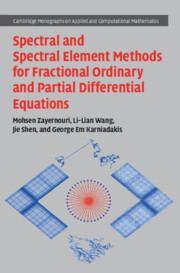311 results

Spectral and Spectral Element Methods for Fractional Ordinary and Partial Differential Equations
- Coming soon
-
- Expected online publication date:
- September 2024
- Print publication:
- 30 September 2024
-
- Book
- Export citation
Evaluation of epiphytic microbiota in red clover and alfalfa on silage fermentation products, bacterial community diversity and functionality of oat
-
- Journal:
- The Journal of Agricultural Science / Accepted manuscript
- Published online by Cambridge University Press:
- 29 April 2024, pp. 1-26
-
- Article
- Export citation
Compression and acceleration processes of spherical shells in gold cones
-
- Journal:
- High Power Laser Science and Engineering / Accepted manuscript
- Published online by Cambridge University Press:
- 29 April 2024, pp. 1-22
-
- Article
-
- You have access
- Open access
- Export citation
Trauma diagnostic-related target proteins and their detection techniques
-
- Journal:
- Expert Reviews in Molecular Medicine / Volume 26 / 2024
- Published online by Cambridge University Press:
- 11 April 2024, e7
-
- Article
-
- You have access
- Open access
- HTML
- Export citation
Structural and resting-state connection abnormalities of habenula in obsessive-compulsive disorder
-
- Journal:
- Psychological Medicine , First View
- Published online by Cambridge University Press:
- 22 March 2024, pp. 1-8
-
- Article
- Export citation
Potential role of hypoxia in maintaining lactation persistency of dairy cows
-
- Journal:
- Animal Nutriomics / Volume 1 / 2024
- Published online by Cambridge University Press:
- 15 March 2024, e3
-
- Article
-
- You have access
- Open access
- HTML
- Export citation
Workshop for the protection of Chinese giant salamanders
-
- Article
-
- You have access
- Open access
- HTML
- Export citation
DNA Methylation Mediated the Association of Body Mass Index With Blood Pressure in Chinese Monozygotic Twins
-
- Journal:
- Twin Research and Human Genetics , First View
- Published online by Cambridge University Press:
- 31 January 2024, pp. 1-12
-
- Article
- Export citation
Identification of Potential Biomarkers of Septic Shock Based on Pathway and Transcriptome Analyses of Immune-Related Genes
-
- Journal:
- Genetics Research / Volume 2023 / 2023
- Published online by Cambridge University Press:
- 01 January 2024, e1
-
- Article
-
- You have access
- Open access
- HTML
- Export citation
Cross-Section Measurements of the 11B(p,α)2α Reaction near the First Resonant Energy
-
- Journal:
- Laser and Particle Beams / Volume 2023 / 2023
- Published online by Cambridge University Press:
- 01 January 2024, e12
-
- Article
-
- You have access
- Open access
- HTML
- Export citation
Isothermal measurement of heats of hydration in zeolites by simultaneous thermogravimetry and differential scanning calorimetry
-
- Journal:
- Clays and Clay Minerals / Volume 55 / Issue 3 / June 2007
- Published online by Cambridge University Press:
- 01 January 2024, pp. 239-252
-
- Article
- Export citation
Synthesis, Structure, and Ferroelectricity of a Kaolinite-p--Aminobenzamide Intercalation Compound
-
- Journal:
- Clays and Clay Minerals / Volume 67 / Issue 6 / December 2019
- Published online by Cambridge University Press:
- 01 January 2024, pp. 461-470
-
- Article
- Export citation
Manipulating the Laser-Driven Proton Bunch with Plasma Wakefield
-
- Journal:
- Laser and Particle Beams / Volume 2022 / 2022
- Published online by Cambridge University Press:
- 01 January 2024, e2
-
- Article
-
- You have access
- Open access
- HTML
- Export citation
The Charge State of Protons with 90 and 100 keV Energies Decelerated in Hydrogen Plasma
-
- Journal:
- Laser and Particle Beams / Volume 2021 / 2021
- Published online by Cambridge University Press:
- 01 January 2024, e15
-
- Article
-
- You have access
- Open access
- HTML
- Export citation
THE INFLUENCE OF PLANT SPECIES AND PRETREATMENT ON THE 14C AGE OF CAREX-DOMINATED PEAT PLANTS OF A PEAT CORE FROM JINCHUAN MIRE, NE CHINA
-
- Journal:
- Radiocarbon , First View
- Published online by Cambridge University Press:
- 28 December 2023, pp. 1-21
-
- Article
-
- You have access
- Open access
- HTML
- Export citation
Live birth rate of gonadotropin-releasing hormone antagonist versus luteal phase gonadotropin-releasing hormone agonist protocol in IVF/ICSI: a systematic review and meta-analysis
-
- Journal:
- Expert Reviews in Molecular Medicine / Volume 26 / 2024
- Published online by Cambridge University Press:
- 14 December 2023, e2
-
- Article
-
- You have access
- Open access
- HTML
- Export citation
Composition and diversity of the gut microbiota across different life stages of American cockroach (Periplaneta americana)
-
- Journal:
- Bulletin of Entomological Research / Volume 113 / Issue 6 / December 2023
- Published online by Cambridge University Press:
- 01 December 2023, pp. 787-793
-
- Article
- Export citation
Prospect of ultrahigh-resolution fast neutron absorption spectroscopy based on a laser plasma electron accelerator
-
- Journal:
- High Power Laser Science and Engineering / Volume 12 / 2024
- Published online by Cambridge University Press:
- 30 November 2023, e11
-
- Article
-
- You have access
- Open access
- HTML
- Export citation










